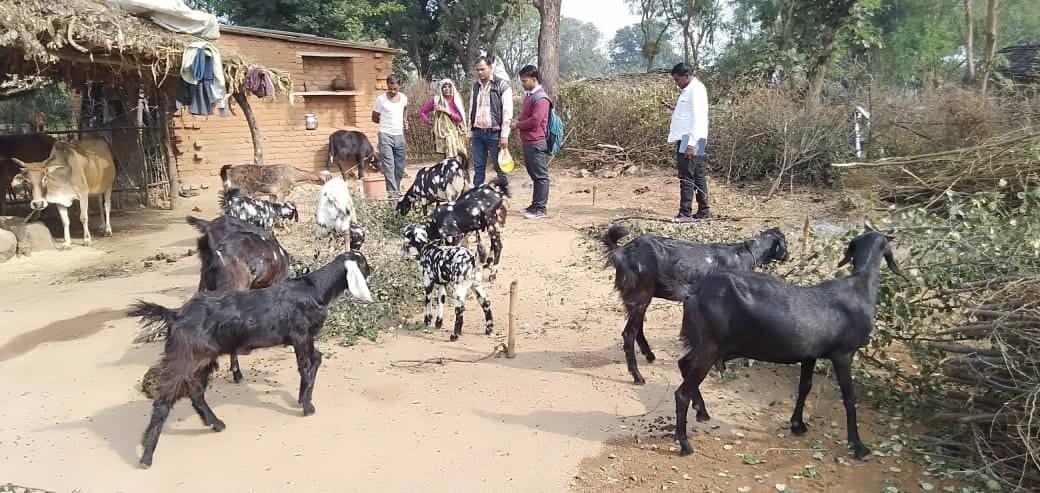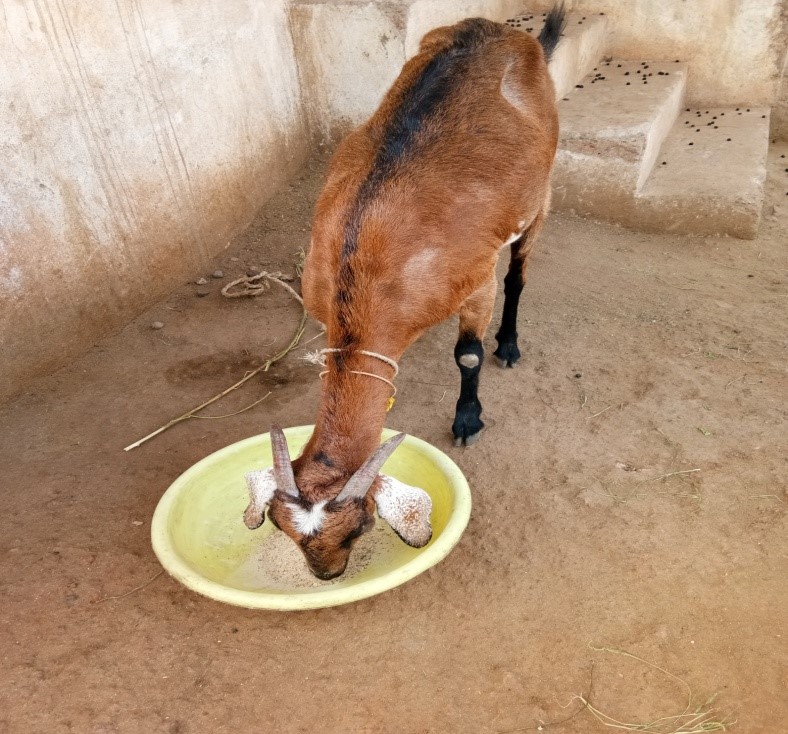Feeding
- Goat diet must include approximately 60-70% of green fodder, 20-30% of dry fodder and 5-10% of concentrate/supplementary feed, providing it about 16-20% of Crude Protein (CP) and 65% of Total Digestible Nutrients (TDN).
- Green fodder should include legumes (guar, berseem, cowpea, lucerne, stylosanthes); non-legumes/cereals (maize, pearl millet, sorghum, oat); grasses (hybrid napier, guinea grass, anjan grass), and fodder trees (Subabul, Sesbania, glyricidia, etc.)
- Concentrate/supplementary feed may be prepared using a combination of maize/soybean/green gram/ cereals (broken/ground/mashed) (30-40%), any oilcake (20-30%), husk/bran (30-40%) and mineral mixture and salt (1-2%).
- Goats can also be fed low grade roughage/residues which are treated in the following methods: physical and mechanical (soaking, chopping, grinding, pelleting, steaming and irradiation); chemical (sodium hydroxide, urea/ammonia, etc.); and biological (fungi).
- Ensure a minimum 250 grams of concentrate and 5 grams each of common salt and mineral mixture in the daily diet of the goat. Additional concentrate/ supplementary feed must be provided to pregnant and lactating animals and breeding bucks.

Nutrients Required
The nutrients needed may be divided into maintenance, production (for milk, meat and hair production) and pregnancy requirements.
Maintenance ration:
The maintenance requirements are related to surface area and basal metabolic rate. Goats have higher basal metabolic rate than cattle; therefore, their maintenance requirements are higher than those of cattle. The requirement by weight is calculated and an additional feed of about 25 to 30 per cent for maintenance is allowed. The maintenance requirement thus calculated is 0•09 per cent digestible crude protein (DCP) and 0•09 per cent total digestible nutrients (TDN). It will be desirable to point out one interesting aspect. For its size the goat can consume substantially more feed than cattle or sheep, viz. 6•5 to 11 per cent of its body weight in dry matter when compared with 2•5 to 3 per cent for cattle or sheep. This means that the goat can satisfy its maintenance requirement and produce milk from forage alone.
Production ration:
Requirements for the production of 1 litre of milk with 3•0 per cent fat is 43 g of DCP and 200 g of starch equivalent (SE), whereas for the production of 1 litre of milk with 4•5 per cent fat it is 60 g of DCP and 285 g of SE.
The nutritional requirements of a goat weighing 50 kg and yielding 2 litres of milk with 4 per cent fat may be met by feeding 400 g of concentrate mixture and 5 kg of Berseem or Lucerne. The ration should have 12 to 15 per cent protein content, depending on the amount of protein in their hay and in the milk produced.
Mineral mixture:
Minerals should be given as an essential part of the ration as they contribute to the building of the skeleton, physiological functions and production of milk. The more important of these salts are calcium and phosphorus. The requirements of calcium and phosphorus for maintenance are 6•5 and 3•5 g, respectively, per 50 kg body weight. Goats require slightly larger quantities of calcium than sheep. The mineral mixture may be included in the concentrate ration at the rate of 0•2 per cent.
Common salt:
Lumps of rock salt are just the' thing for them. These lumps of salt, of fairly good size, should be hung up in some suitable place where goats can easily get at them, or else they may be kept in the manger. The provision of salt licks is very important for goats as they secrete a good amount of sodium and chloride ions in milk. The salt often helps to tone up the system and may even have some effect in removing worms from the body. Salt to the extent of 2 percent may also be mixed with the daily grain ration of goats.
Vitamins and antibiotics:
Goats need particularly vitamins A, D and E. The microbes in the rumen synthesize most of the other needed vitamins. Vitamin A can be supplied by feeding green forage and yellow maize. One kg of lush-green fodder will provide. Synthetic vitamins A and D may be included in the ration of growing kids.
Feeding of aureomycin or terramycin increase the growth rate of young kids, reduces the incidence of scours and other infectious diseases and improves the general appearance of the kids.

Generally, goat feed nutrients are divided into six groups. These nutrients are:
-
Protein:
It is the only nutrient that contains nitrogen. Protein quality - a term referring to the amino acid content - has no significance in ruminant nutrition, except at exceptionally high levels of milk production. Rumen microorganisms manufacture their own body protein, consisting of all the necessary amino acids, which are later digested by the host animal. Protein makes up the basic animal tissue of the body and is vital for growth, milk production, disease resistance, reproduction, and general maintenance. Protein requirements vary between 12 and 16 percent of the ration dry matter with the latter needed for high milk production. -
Energy:
Most of the goat's energy comes from the breakdown of the fiber of forages, while the remainder comes from the burning up of concentrate starches and fats. Over a longer period of time effects such as retarded growth, delayed puberty, and decreased fertility will become apparent. Energy is measured in two different ways by the feed industry. These methods are Total Digestible Nutrients (TDN) and Net Energy System. -
Minerals:
The major minerals of concern are calcium, phosphorus, and salt, which are usually added to the ration either in the grain mix or by free-choice feeding. Goats do not consume minerals free choice according to their needs. It is, therefore, recommended that minerals be force-fed through the grain mixture or mixed with a succulent feed like silage or green chop, if possible. The ratio of calcium to phosphorus is important and should be kept around 2:1. Vitamins:
Since all the B vitamins and vitamin K are produced in the rumen and vitamin C is manufactured in the body tissues, the only vitamins of concern in ruminant nutrition are vitamins A, D, and E. During the late spring, summer, and early fall the animals can get all they need from green pastures and plenty of sunshine. In addition, they can store a good supply of these vitamins to carry them into the winter months. Nevertheless, it is a good idea to add these vitamins at the rate of 6 million units of vitamin A and 3 million units of vitamin D to each ton of grain mix during the winter months as an added precaution.Fats:
Fats are of little importance in the ruminant ration. Practically all feeds contain small amounts of fat, and added levels are not practical. A level of 1.5 - 2.5 percent in the grain mixture is normal.Water:
This is the least expensive feed ingredient, yet a deficiency will affect milk production more quickly than the lack of any other nutrient. Water is not only the largest single constituent of nearly all living plant and animal tissue, but it also performs exceedingly important functions during digestion, assimilation of nutrients, excretion of waste products, control of body temperature, and the production of milk. Ready access to water is important. Goats with water constantly available have been shown to produce more milk than those watered twice daily and over 10 percent more than those watered only once per day.
| Nutrient composition and feed formulation of supplementary feed (concentrate mixture) for goats. | |||
|---|---|---|---|
| First combination | Second combination | ||
| Ingredients | Quantity for 100 kg | Ingredients | Quantity for 100 kg |
| Maize | 30 | Maize/soybean/ green gram/cereal (broken/ground) mash | 30-40 |
| Groundnut cake | 5 | ||
| Soybean | 5 | Any oilcake | 20-30 |
| Green gram chuni | 10 | Husk/bran | 30-40 |
| Rice polish | 5 | Mineral mixture and salt | 01-02 |
| Wheat bran | 40 | Total | 100 |
| Limestone | 2 | Goats should be fed about 250-400 gms daily based on their growth stage. | |
| Mineral mixture | 1 | ||
| Salt | 2 | ||
| Total | 100 | ||
| Major raw materials and their sources used in making supplementary/concentrate feed. | |||
|---|---|---|---|
| Raw materials | Sources | ||
| Cereals and millets | Sorghum (jowar), maize, pearl millet (bajra), finger millet (ragi), rice, oats, wheat, etc. | ||
| Oilseed cake | Soybean meal, groundnut cake, cotton seed cake, sunflower cake, silkworm pupae meal, coconut cake | ||
| Agro-industrial by-products | Rice bran, wheat bran, rice polish, deoiled rice bran, chuni | ||
| Mineral and vitamin mixture | Calcite grit, calcium carbonate, ground limestone, oyster shell, steamed bone meal, monosodium phosphate, dicalcium phosphate, defluorinated rock phosphate, soft rock phosphate | ||
Flushing
Improving the nutritional status of ewes during 3-4 weeks prior to mating is known as ‘flushing’. Nutrition and body condition of the ewes prior to putting them to ram are important. Flushing will have effect only if the ewes were in declining phase of nutritional availability. Ewes in better body condition will produce more lambs and thus the flushing of leaner ewes will increase the fertility by way of increased incidence of oestrus and increased ovulation rate. To obtain increased lambing rate, the breeding ewes, 4-6 weeks prior to their being bred, should be supplemented with 250g of concentrate mixture or 500 g of good quality legume hay per head per day.
Transition Feeding
With the time between weaning and mating, ewes should nutritionally replenish losses from the previous kidding. It is advisable to increase level of nutrition before and after mating, resulting in higher ovulation and conception rates, and to make provision for the additional nutritional needs in late pregnancy and early lactation. The transition period is considered by many nutritionists and academicians as the time period of late pregnancy to very early lactation. It is often a varying period, which depends on the species of livestock. Over this very short period, the animal is forced to deal with radical changes such as: difficulties of gestation, parturition, onset of lactation, appetite fluctuations (from a gestation diet to a lactation diet), and fluctuations in hormone levels. Approximately the concentrate mixture consists of 15% crude protein (CP) and 65% total digestible nutrients (TDN) as per book values which can be prepared using the ingredients like maize (30 %), groundnut cake (5 %), soya bean (5 %), green gram chuni (10 %), rice polish (5 %), wheat bran (40 %), limestone (2 %), mineral mixture (1%) and salt (2 %). The supplementary feeding composition can be varied depending on the availability of inputs and socio-economic status of the farmers at field conditions.


